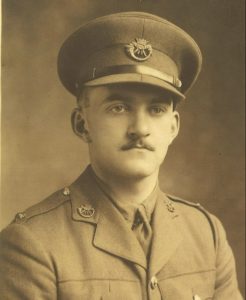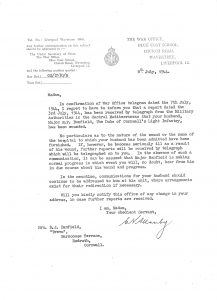Major Eldred P Banfield
B Company Commander, 2nd Battalion Duke of Cornwall’s Light Infantry

As B Company Commander of the 2nd, Major Banfield was a leader, often taking charge from the front during many of the battalion’s hardest fought battles. Apart from a photograph of Banfield in ‘Walking out dress’ as part of the DCLI Militia, the earliest image we have of him is as ‘Lieutenant Banfield’. Here, he can be seen in the photograph below with a group of fellow officers at Ashurst Camp in the New Forest in 1941.

Unfortunately however, Banfield’s time fighting alongside the 2nd Battalion in the field, came to an abrupt end on 27th June 1944. During a successful attack as part of the Battle of Casamaggiore, Italy, the senior officer sustained serious injuries to his leg. Banfield was evacuated from the field and taken to the British 103 General Hospital in Nocera, Campania in the province of Salerno.
It is during this time, spent as a patient, that the true remarkability of his character is made evident. Through examining copies of the correspondence between Banfield and other men of the 2nd battalion during the senior officer’s time in hospital, it is clear to see how he was generally, held in the highest regard. The respect he engendered amongst his comrades, not only from fellow officers but also the men under his command, can only be testament to his sense of leadership and character.
The first letter to be discussed is appropriately from his Commanding Officer, Lieutenant-Colonel Musson, (Officer Commanding 2nd Battalion DCLI). Almost immediately, Musson refers to Banfield by his nickname; ‘Banners’ and after some initial questioning regarding his health, the commanding officer, moves straight to the exploits of B Company. In particular, how well they fought in the battle in which Banfield was wounded and the subsequent action two days later. It is sobering to realise that the casualties in these two battles were heavier than those sustained by the Battalion at Monte Cassino. Rather morbidly, Lt. Col Musson then goes onto name some of these casualties. At one stage, he also referred to a fellow Serjeant as going ‘bomb-happy after the last attack’; a condition today that would be termed Post Traumatic Stress Disorder (PTSD). Finally, Musson details some of the losses from Banfield’s Command, B Company. At least Musson finishes on a more uplifting note, wishing ‘Banners’ a speedy recovery and a return to his ‘old Company’.
On 25th July Lt. Col. Musson wrote another letter, thanking Banners for his good wishes on the Distinguished Service Order (DSO) but nevertheless, lamenting the fact that Major Banfield was likely to be out of action for some time. Musson follows up with what might be termed ‘fatherly’ advice, showing concern for an officer that had given so much. He goes onto say ‘you have done your bit’ and closes with a heartfelt thanks for improving, ‘your Company beyond my wildest expectations’.
There are 11 more letters within our archives at Bodmin Keep, from both officers and other ranks that bring Banners up to speed on the fate of the Battalion, especially ‘the old boys’ in B Company. The letters all praise Major Banfield, and some include the odd ‘grouse or two’ as well as news on progress and the latest casualties. The 11 letters cover the period from 13th August 1944 to 13th August 1945. It is quite obvious from them, that the strain of constant combat is beginning to tell on the veterans of the Battalion. In one letter, there is a remarkedly moving passage that sums up the trauma these brave men went through. Please note the names of the casualties have been changed.
‘during the last show Smith was killed and Jo wounded Hancock killed, these are just a few that you know, Stephen and Jo were with me at the time and it took me 6 hours to get Stephen away he died bravely telling me he was using all his will power to live- he wanted to so badly, I think that is the part that has shaken me so, I can’t concentrate, just think about them all and find myself weeping, I’ve been caught out once by Parsons, but I don’t think he will say anything, anyway, I’m hoping this rest will put me right, and hoping this war will be over before we go back again.’
Within our archives, we also hold an official Post Office Telegram addressed to Mrs B J Banfield. One cannot simply fathom the horror of receiving such a Telegram during the war and the relief Mrs Banfield must have felt when the telegram informed her that Major Banfield was ‘only’ wounded and not killed. In addition to the dry impersonal language, the crucial information of the wounding was written towards the end of the telegram. Perhaps, it would have been ‘kinder’ to include this nearer the start?

Furthermore, on 11th July 1944 Mrs Banfield was sent a letter by the War Office (see above image). Probably a fairly standard piece of text which attempts to ‘comfort’ the relative? What do you make of it? How would you feel receiving such a letter?
Written by Andrew Sims, Archivist at Bodmin Keep, May 2021
